7.8 /10 1 Votes
Cabinet Upright, cocktail Genre Shoot 'em up | 7.7/10 Arcade Division Initial release date 1980 | |||||||||||||||||||||||||||||||||
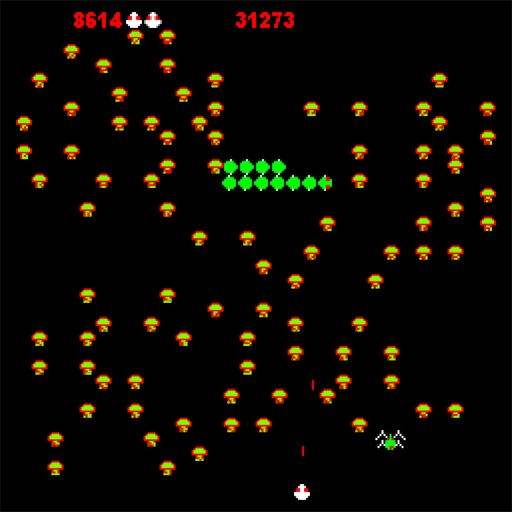 | ||||||||||||||||||||||||||||||||||
Release date(s) Arcade1980Atari 2600NA: 1982EU: 1982Atari 5200NA: 1982Atari 7800NA: 1987EU: 1987 Mode(s) Up to 2 players, alternating turns CPU 1x MOS Technology 6502 @ 1.512 MHz Sound 1x Atari POKEY @ 1.512 MHz Display Raster, 240×256, vertical orientation, palette colors 16 Similar Atari games, Shoot 'em up games | ||||||||||||||||||||||||||||||||||
Centipede is a vertically oriented fixed shooter arcade game produced by Atari, Inc. in 1980. The game was designed by Ed Logg and Dona Bailey. The player fights off centipedes, spiders, scorpions and fleas, completing a round after eliminating the centipede that winds down the playing field.
Contents
- Gameplay
- Scoring
- Development
- Reception
- Re releases
- Sequels
- Arcade clones
- Home system clones
- Board game
- Competitive arena
- In other media
- References
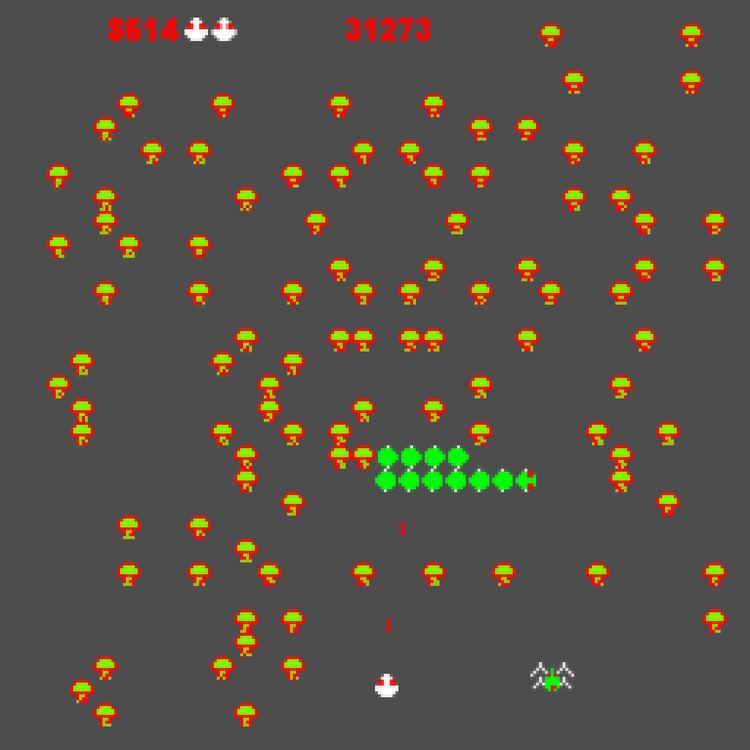
Centipede was ported to Atari's own Atari 2600, Atari 5200, Atari 7800, and Atari 8-bit family. Under the Atarisoft label, the game was sold for the Apple II, Commodore 64, ColecoVision, VIC-20, IBM PC (as a PC booter), Intellivision, and TI-99/4A. Superior Software published the port for the BBC Micro.
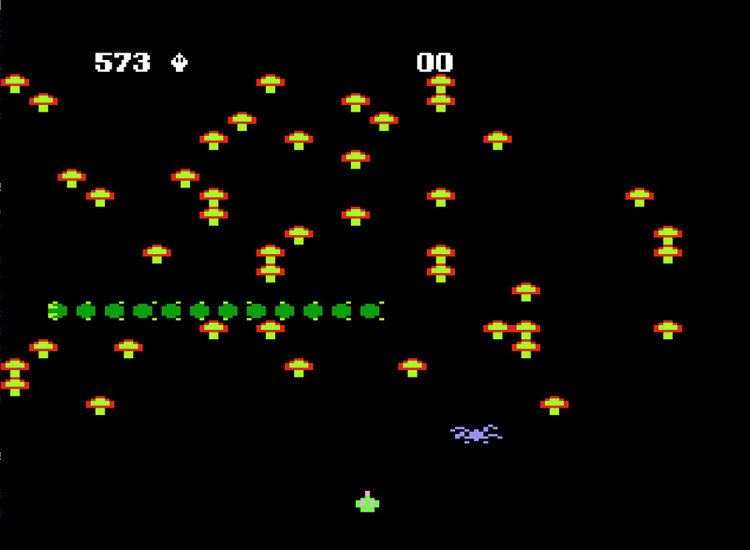
Gameplay
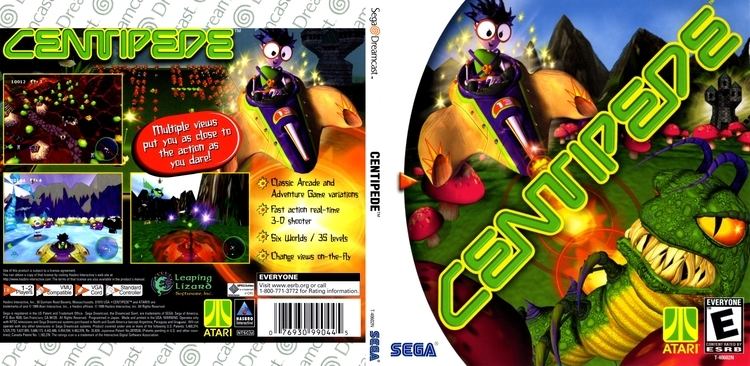
The player is represented by a small, "somewhat humanoid head" at the bottom of the screen, later depicted as a caped, elf-like character on the Atari 2600, Atari 5200 and Atari 7800 cartridge graphics (though described as being a garden gnome in the trivia section of the cell phone interpretation). The player moves the character about the bottom area of the screen with a trackball and fires laser shots at a centipede advancing from the top of the screen down through a field of mushrooms. Shooting any section of the centipede creates a mushroom; shooting one of the middle segments splits the centipede into two pieces at that point. Each piece then continues independently on its way down the board, with the first section of the rear piece becoming a new head. If the head is destroyed, the section behind it becomes the next head.
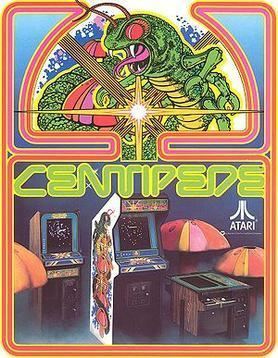
The centipede starts at the top of the screen, traveling either left or right. When it hits a mushroom or the edge of the screen, it drops one level and switches direction. Thus, more mushrooms on the screen cause the centipede to descend more rapidly. The player can destroy mushrooms by shooting them, but each takes four hits to destroy.
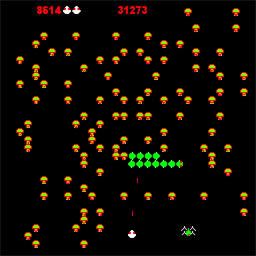
If the centipede reaches the bottom of the screen, it moves back and forth within the player area and one-segment "head" centipedes are periodically added. This continues until the player has eliminated both the original centipede and all heads. When all the centipede's segments are destroyed, a new centipede forms at the top of the screen. Every time a centipede is eliminated, however, the next one is one segment shorter and is accompanied by one additional, fast-moving "head" centipede.
The player is also menaced by other creatures besides the centipedes. Fleas drop vertically, leaving additional mushrooms in their path; they appear when fewer than five mushrooms are in the player movement area, though the number required increases with level of difficulty. Spiders move across the player area in a zig-zag fashion and occasionally eat some of the mushrooms. Scorpions move horizontally across the screen and poison every mushroom they touch, but these never appear in the player movement region. A centipede touching a poisoned mushroom hurtles straight down toward the player area, then returns to normal behavior upon reaching it.
A player loses a life when hit by a centipede or another enemy, such as a spider or a flea, after which any poisoned or partially damaged mushrooms revert to normal. Points are awarded for each regenerated mushroom. A game ends if all lives are gone.
Scoring
Players earn extra lives per 10,000, 12,000, 15,000, or 20,000 points scored. May have up to 6 lives. 999,999 points is the maximum high score.
Development
Ed Logg and Dona Bailey developed Centipede for Atari. Bailey was one of the few female game programmers in the industry; Logg stated that the game was intended to attract women players, and Bailey said "I really like pastels ... I really wanted it to look different, to be visually arresting". Bailey and Logg succeeded in their goal; Centipede was one of the first arcade coin-operated games to have a significant female player base after Pac-Man.
Reception
In 1983 Softline readers named Centipede ninth on the magazine's Top Thirty list of Atari 8-bit programs by popularity. The game received the award for "1984 Best Computer Action Game" at the 5th annual Arkie Awards where the judges described it as "pack[ing] a real roundhouse punch", and suggested that some "insist that [the Centipede] Atari cartridge is the best home-arcade edition you can buy".
In a 1984 Video review of the Apple II version of the game, Bill Kunkel and Arnie Katz commented that "the graphic limits of the Apple crimp the style," and expressed disappointment in the game's "sluggish" interfacing with trackball controllers.
Re-releases
Centipede was included in the Sega Genesis Arcade Classics release, including this game as one in three. There was also a Game Gear game under the same title, and a similar Master System compilation titled Arcade Smash Hits.
Centipede was released for the Microsoft Windows 3.x, in 1993 as part of the Microsoft Arcade; in the Arcade Classics series for Game Boy by Nintendo and Accolade in 1995 (while a different Game Boy Color port was published by Majesco and released in 1998); in 1999 as part of Arcade's Great Hits: The Atari Collection 1 for Sega's Saturn and Sony's PlayStation, in a remake containing the original for Sony's PlayStation, Sega's Dreamcast, and Microsoft Windows 9x in 2000; in 2003 as part of Atari: 80 Classic Games in One!. Atari Anniversary Edition Redux, released in 2001, also contained game within the collection, again for Sony's PlayStation, Sega's Dreamcast, and Microsoft Windows 9x.
Centipede has also been made available for the Xbox and PlayStation 2 (in both arcade and Atari 2600 versions) as part of Atari Anthology in 2004. The Xbox Live Arcade and PlayStation Portable's Atari Arcade Classics version was bundled with the sequel Millipede, which included an "evolution mode", featuring high-definition graphics and special effects like motion blur, trails, and particle-based explosions. Centipede was released via Xbox Live Arcade for the Xbox 360 on May 2, 2007.
Glu Mobile released a licensed cellular phone version of Centipede that includes the original game as well as updated gameplay, skins, and modes. In later 2008, Atari released the game via Apple's App Store for the iPhone and iPod Touch.
Sequels
Centipede was followed by Millipede in 1982, a somewhat less successful arcade game. In 1992, Atari Games developed a prototype of an arcade game called Arcade Classics for their 20th anniversary, which includes Missile Command 2 and Super Centipede with co-op 2-player mode.
In 1998, Hasbro-owned Atari Interactive released a new version of the game for the PC, PlayStation, and Dreamcast. This version looks and plays very differently from the original game, with free movement around the map, 3D graphics, and a campaign which can be played in single-player or multiplayer mode. The original version of Centipede is available in this version, with slightly updated graphics.
Arcade clones
Home system clones
Board game
In 1983, Milton Bradley released a board game based on the video game. The board game pits two players against each other in a race to be the first person to the opponent's home base with a centipede. Each player can utilize a blaster, as well as a scorpion and spider, to slow the opposing centipede's advance.
Competitive arena
Donald Hayes of Windham, New Hampshire, USA, scored a world record 7,111,111 points under tournament rules on the arcade version of Centipede on November 5, 2000.
The world record marathon score on the arcade version of Centipede was 16,389,547 points by Jim Schneider of the USA on June 11, 2004.
In other media
In 1989, a deadpan narration describing the original game appeared on side 2 of Negativland's third cassette release, The Weatherman (SSTC902), which consisted of clips from the live Over the Edge radio show sometime between 1982 and 1984. The narrator may be Ed Logg.
American Indie Rock band The Strokes featured the promotional artwork for the game on their 2004 single, Reptilia.
Centipede appears in the film Pixels.
In May 2016, It was announced that Emmett/Furla/Oasis Films has closed a deal to partner with Atari to produce and finance both Centipede and Missile Command.
